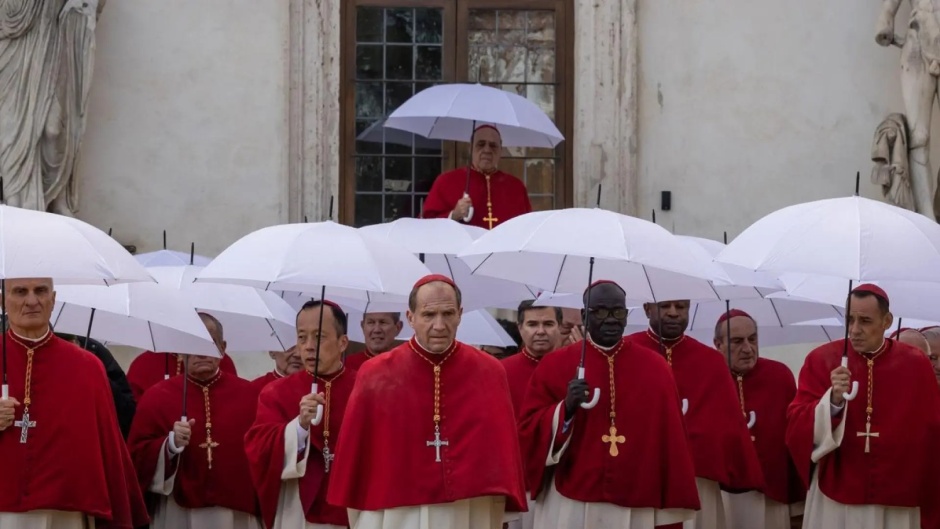The movie only anticipates some outcomes that are consonant with respect to the “catholic” (inclusive, all-embracing) direction that Jorge Bergoglio imprinted on the Roman Catholic Church.
 A scene of the film Conclave.
A scene of the film Conclave.
It is no secret that the conclave (i.e. the assembly of cardinals for the election of a pope) always arouses voyeuristic interest.
(This review includes spoilers of the film)
What happens inside the Sistine Chapel at the Vatican among the cardinal electors once the “extra omnes” (everyone out) is decreed is a source of almost morbid curiosity. In recent years, movie director Nanni Moretti chronicled his conclave in the film Habemus Papam (2011).
Now, Swiss director Edward Berger is trying again with his own Conclave (2024), based on the novel of the same title by Robert Harris.
The film’s plot and setting are typical of the genre: the pope dies, and the “sede vacante” (vacant seat) is declared. The operations of the election of a successor then begin, culminating in voting in the Sistine Chapel. After an open-minded pope on doctrine and morals, different fronts clash: there is the progressive candidate who wants to continue the policies of the previous one, there is the conservative candidate who wants to bring the Catholic Church back into the groove of tradition, there is the “center” candidate who aims to administer the system by freezing the ongoing diatribes, and there is the African candidate who embodies the openness of Roman Catholicism to the global south.
In his homily at the beginning of the conclave, the Dean of the College of Cardinals says that it is no longer the time for “certainties” but for doubt and that the church must be the home of diversity that must be welcomed.
[destacate]A Jesuit mark of Francis' papacy is the exaltation of ambiguity, stigmatizing traditionalism as a backward flight[/destacate]It is a clue to the narrative so close to that of Pope Francis that it forms the spiritual framework of the film. Indeed, a Jesuit mark of Francis' papacy is the exaltation of confusion and ambiguity, generating new solutions and stigmatizing traditionalism as a backward flight.The film chronicles how tight negotiations are constructed and unraveled over one candidate or the other. In short, all the strong candidates, one by one, fall under the weight of skeletons kept in the closet and which emerge during the conclave. The careerist and clericalist candidates involved are routed one by one. This, too, is a feature of the film that reflects a tendency dear to Pope Francis. Several times, Pope Francis has said that the Catholic Church is full of officials who are not shepherds who “smell of their flock” and who instead aspire to power. In the film, these corrupt candidates are exposed and pushed aside.
Eventually, in a conclave riven by scandal and conflict, the latest and unknown cardinal becomes pope. He comes from Baghdad, the “end of the earth,” as Jorge Bergoglio said of himself. He is outside the Roman system. He has been a priest in cities and countries at war: rather than the halls of power, he has been close to those who suffer. He is not doctrinaire, and in his brief address to the cardinals, he talks about inclusion, mercy, and universal fraternity.
These are clearly themes that Francis always stressed. The new pope, both geographically and spiritually, resembles a candidate who mirrors Pope Francis' portrait of the ideal priest. He seems to have no certainties except that of a church that embraces everything and everyone.
[destacate]Who does not remember the “who am I to judge” with which Pope Francis introduced himself to the world?[/destacate]But there is more. While the new pope is in the “room of tears” (a small antechamber within the Sistine Chapel where a newly elected pope changes into his papal cassock for the first time), it turns out that he is also intersex. The pope who selected him as a cardinal had encouraged him to undergo uterine removal surgery, but he eventually refused, and the pope appointed him anyway.
The election took place, so there is not much room for maneuver. Moreover, the conclave had opened with a call to abandon certainty and open up to doubt. Now, the new pope precisely embodies that uncertainty and fluidity and invites acceptance of what is different and outside the traditional patterns.
Is this not the message of Pope Francis over the years of his papacy? Who does not remember the “who am I to judge” with which he introduced himself to the world? Who has not noticed the “todos, todos, todos” (all, all, all) that has been the refrain of his speeches? Who does not have in mind the blessing of people involved in homosexual relationships? Who has not heard the pope say that we are “all children of God”?
Here is the point: the film Conclave takes the seeds planted by Pope Francis during his pontificate to their extreme consequences. It seems that the novel on which it is based, although written by Robert Harris, was inspired by an idea of Pope Francis.
The movie only anticipates some outcomes that are perhaps unsettling and excruciating, but congruent and consonant with respect to the “catholic” (inclusive, all-embracing) direction that Jorge Bergoglio imprinted on the Roman Catholic Church.
Leonardo De Chirico, theologian and evangelical pastor in Rome.
[analysis]
[title]Join us to make EF sustainable[/title]
[photo][/photo]
[text]At Evangelical Focus, we have a sustainability challenge ahead. We invite you to join those across Europe and beyond who are committed with our mission. Together, we will ensure the continuity of Evangelical Focus and Protestante Digital (Spanish) in 2025.
Learn all about our #OneMoreYearEF campaign here (English).
[/text][/analysis]

Las opiniones vertidas por nuestros colaboradores se realizan a nivel personal, pudiendo coincidir o no con la postura de la dirección de Protestante Digital.
Si quieres comentar o